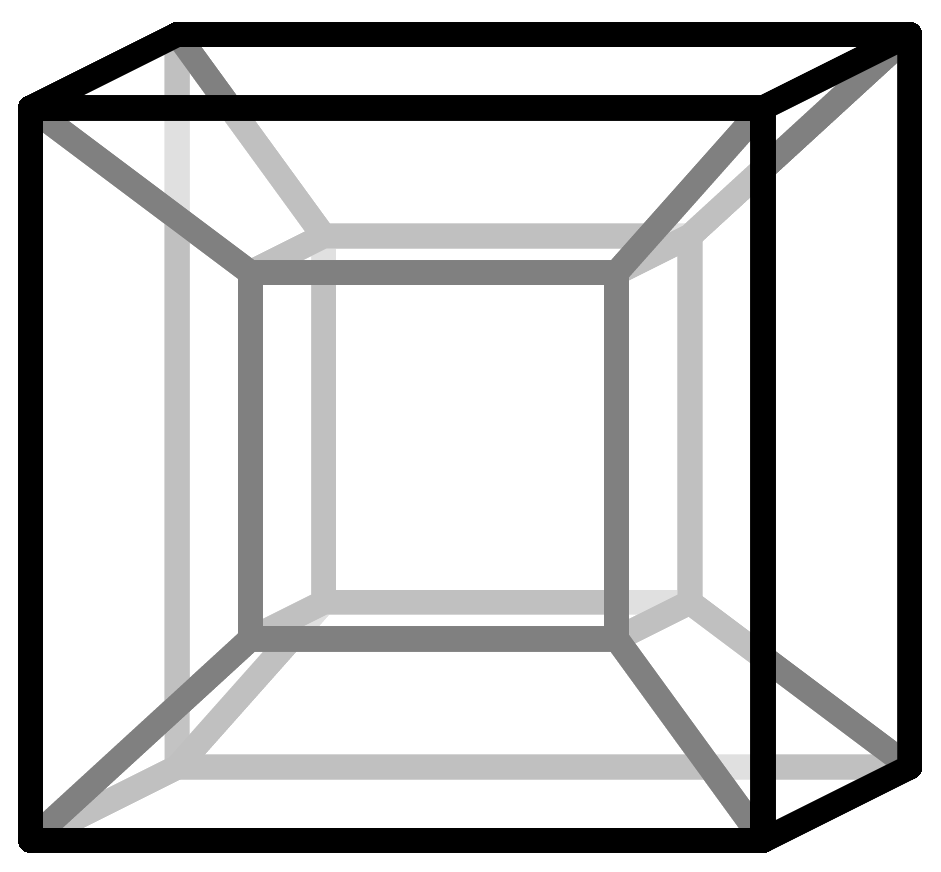Glossary
Polyhedron
Polyhedra are geometrical bodies that consist of vertices, straight edges and flat faces. In our project we restrict ourselves to convex polyhedra. This means that all inner angles between two edges or two faces are less or equal to 180°. No cavities, holes or indentations are allowed.
The most prominent examples of polyhedra are the cube and the pyramid. You also may have encountered the prism or the octahedron. But there are so many more polyhedra.
The Platonic solids are a very symmetric and regular class of five polyhedra. They consist only of congruent (same shape and size), regular (all sides the same length) polygons. The tetrahedron, the octahedron and the icosahedron comprise of regular triangles. In every corner of the tetrahedron, three triangles meet. In the case of the octahedron four and with the icosahedron five triangles build a joint at each vertex. If you put six equilateral triangles at a vertex, which each have an interior angle of 60°, you get a full circle of 360° and they lie flat on the ground. Therefore, no new body emerges. Similarly, the cube is built from three squares and the dodecahedron from three equilateral pentagons at each vertex. Euclid used this approach in his proof to show that there can be no further polyhedra with these properties, thus classifying the five Platonic solids.
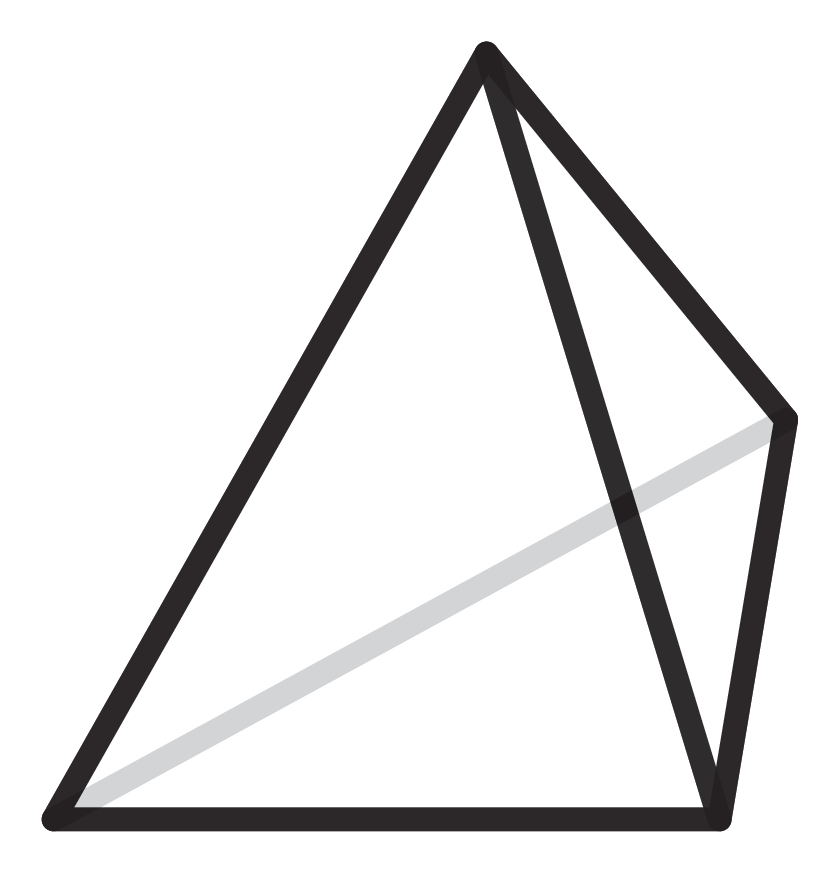
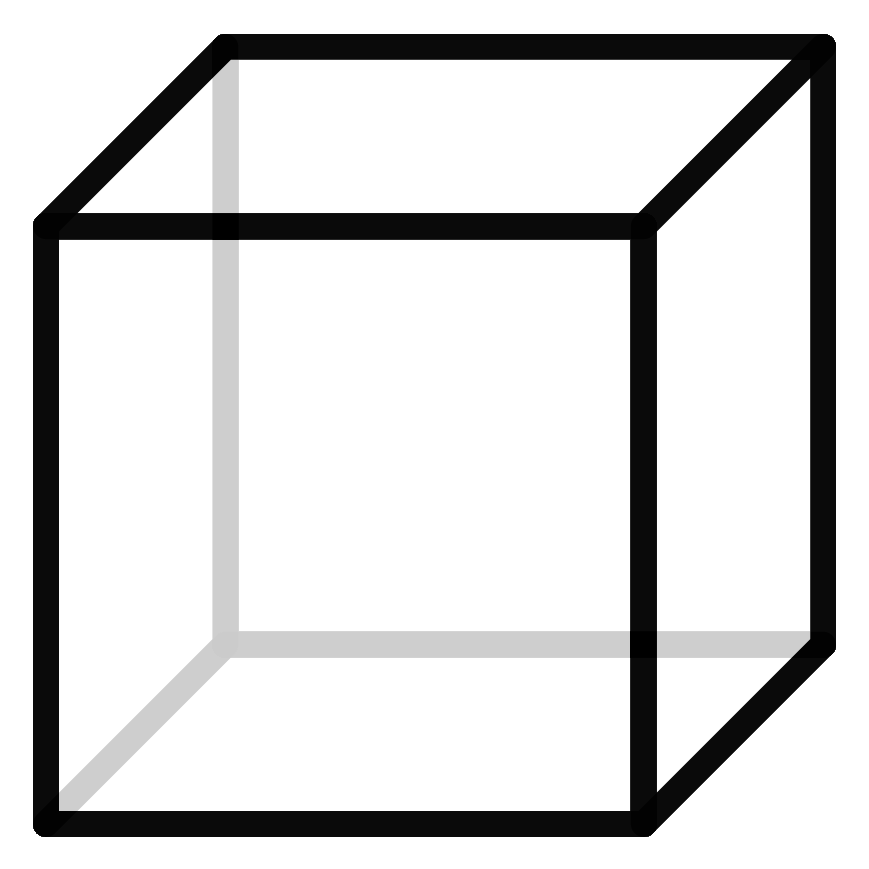
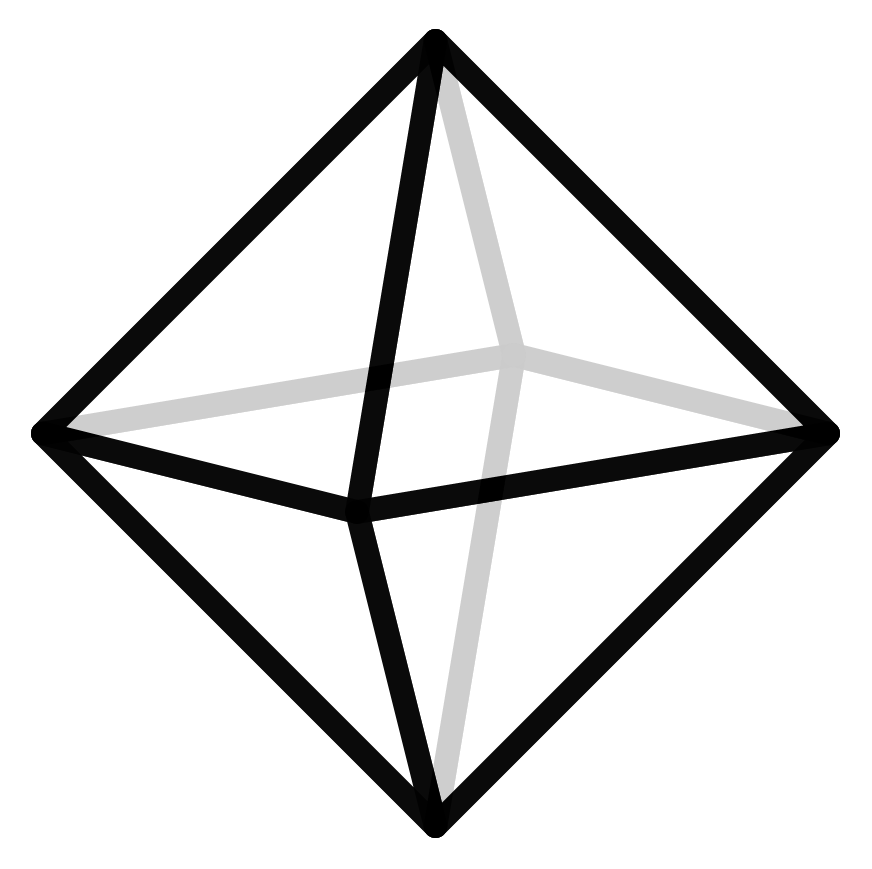

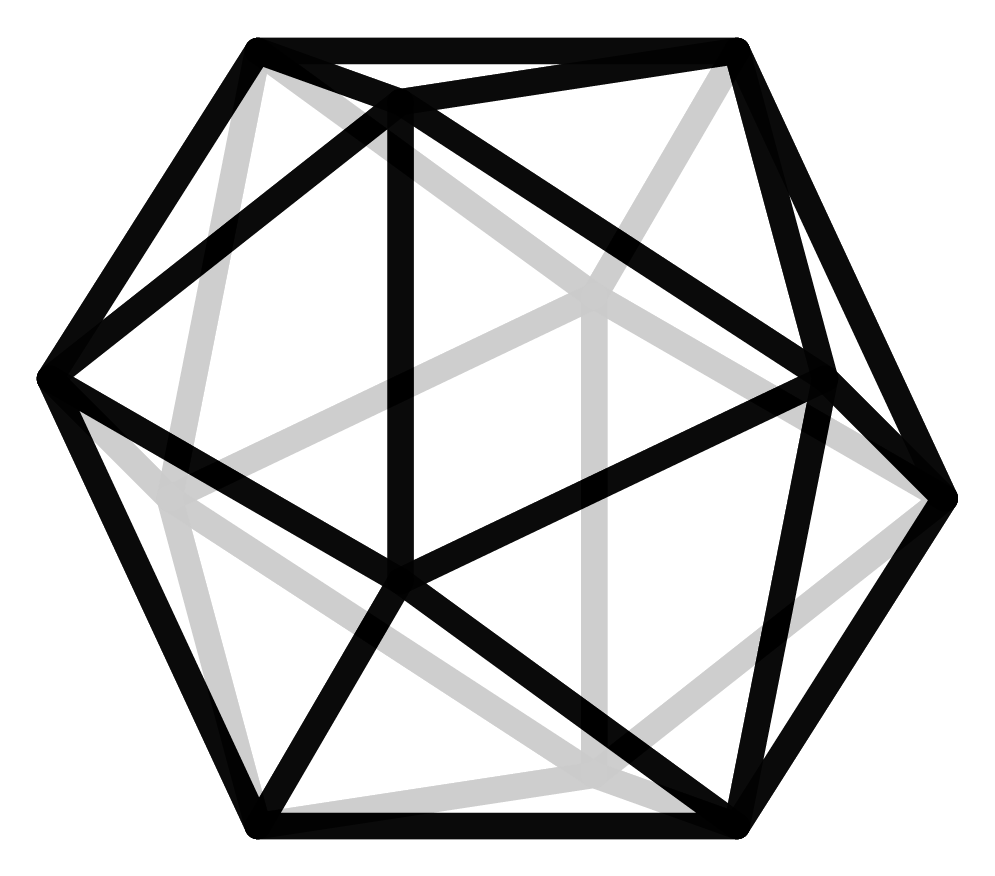
But symmetric polyhedra are not the only interest of mathematicians. For their research they are searching for polyhedra (or their higher-dimensional equivalent, the polytopes) that have specific properties. We have asked some geometers – this is what the mathematicians who study geometry are called – about their favorite polyhedra and this is what they said:
“If polytopes could be viewed as rocks, then the associahedron is the diamond of polytopes. Diamonds are made of a very common element in nature–carbon–and likewise the associahedron can be realized via very common tools. Yet it enjoys such a unique and rare structure–and provides such a fascination–that no other polytope may ever be compared to the diamond.” - Jean-Philippe Labbé.

“My favorite 3-polytope is the icosahedron, for its complexity yet simplicity. If you start gluing equilateral triangles, five at a vertex, and no matter what you do you end up with this nice thing. When I got bored in high school (which, yes, happened), I drew icosahedra in the margins in my notebooks. Sometimes they were not totally regular; I amused myself making them look like faces. Last but not least, I am fascinated by the fact that you can decompose its 12 vertices into three golden rectangles intertwined as Borromean rings.” - Francisco Santos.

“My favourite polyhedron is “Miller’s solid”, also known as the ”pseudo-rhombicuboctahedron“ or as the ”elongated square gyrobicupola“, probably first found by D. M. Y. Sommerville in 1905 — an object that was often overlooked (already by Archimedes?), discovered and rediscovered (by J. C. P. Miller, among others). It is pretty, but if you look closely it has a certain twist, so it is not perfect. It looks classical, like an Archimedean solid, but it isn’t really, at least according to the modern definition of an Archimedean solid. Thus it is a good reminder that we have to be careful with definitions in mathematics, and always look at possible exceptions and special cases.” - Günter M. Ziegler.
„My favourite polyhedra are the Koebe polyhedra. All their edges touch a sphere. All faces of these polyhedra have inscribed discs. The discs of neighbouring faces touch. These exist an explicit dualization procedure that generates discrete minimal surfaces from Koebe polyhedra. The corresponding surface is then a discrete P-Schwarz surface and the Koebe polyhedron is its Gauss map. One can read more in: A.I. Bobenko, T. Hoffmann, B.A. Springborn, Minimal surfaces from circle patterns: Geometry from combinatorics, Ann. of Math. 164:1 (2006) 231-264) and can watch the movie: (http://discretization.de/en/movies/koebe/).“ - Alexander Bobenko.
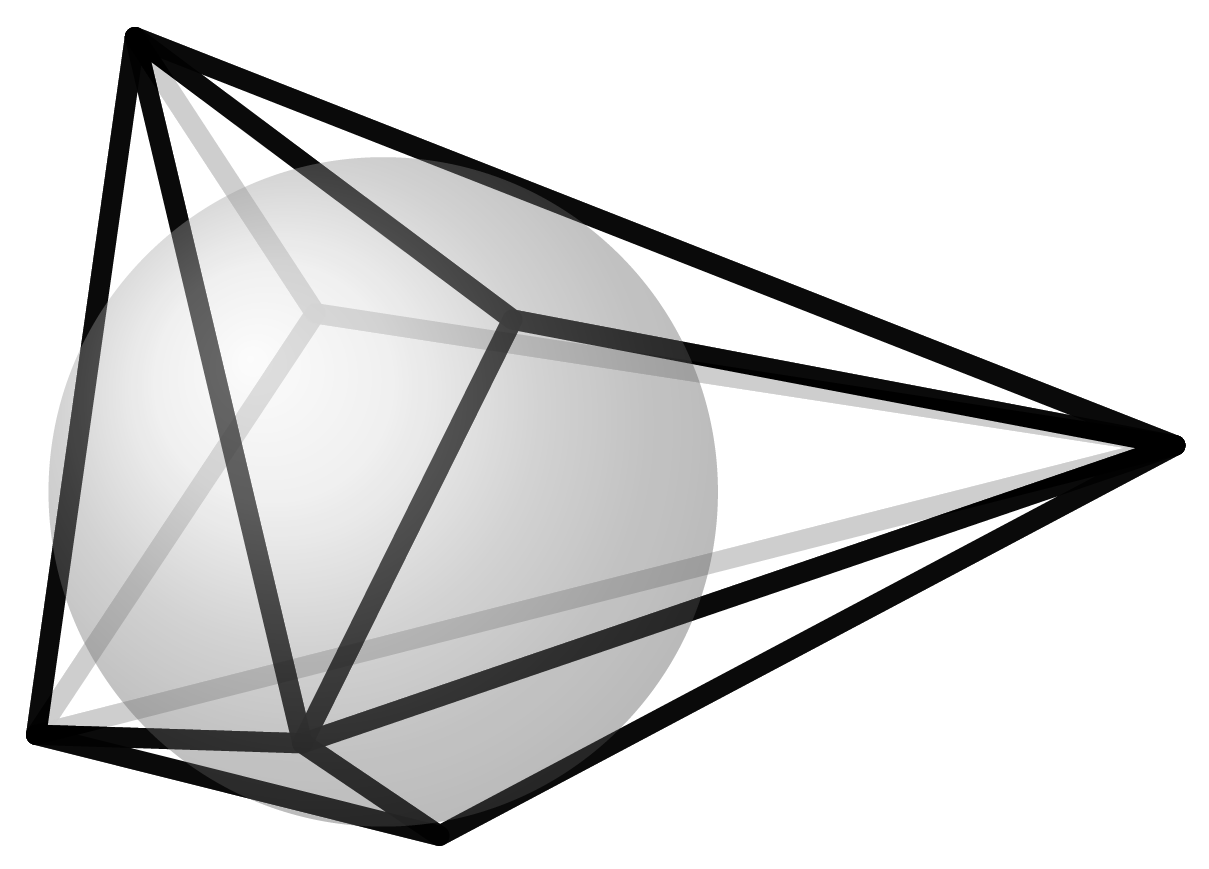
Polygon
A polygon is a two-dimensional polyhedron which consists of vertices and edges. The area bounded by the edges is the polygon itself. Three-dimensional polyhedra are made up of vertices, edges and polygons, i.e., the faces.
A special class of polygons are called the regular polygons. They are made up of equilateral edges (all the same length) and all their inner angles are the same. Some examples of regular polygons are the square, equilateral triangle, and equilateral pentagon. Regular polygons form the building blocks for the Platonic and Archimedean solids.
Polyhedral Nets
If you cut a hollow cube on enough edges, unfold it and lay it flat on the plane, you get what is called the net of the cube. If you draw this net on paper, you get an outline which you can cut out and glue together to form the cube. Of course, this method works for any polyhedra. In our project, we use exactly these templates to build our models. We simulated this process of cutting open and unfolding polyhedra with a computer and automatically created the nets of the polyhedra.


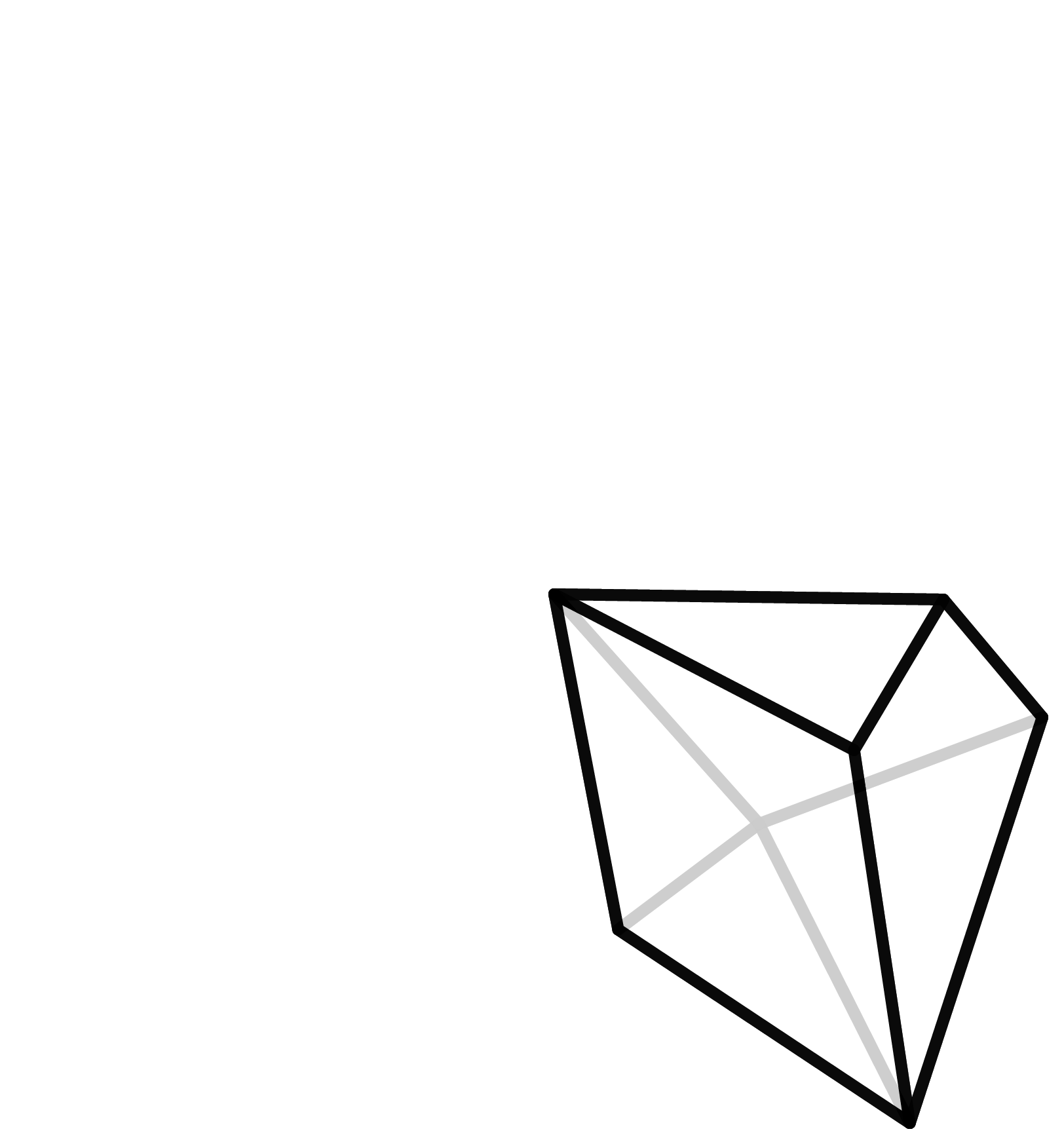

A cube with its net and a polygon with seven corners and the associated net.
Archimedian Solids
Another very symmetric and hence “beautiful” class of polyhedra are the Archimedean Solids. They also only consist of regular polygons, but here unlike the Platonic Solids a combination of them is allowed. The most common representative is the soccer ball. Mathematicians would rather speak of a truncated icosahedron, since it emerges when you chop off the tip of each vertex of an icosahedron.


On the left an icosahedron and on the right its truncation - a soccer ball.
How many polyhedra are there?
For every fixed number of vertices, there are a certain number of polyhedra. In the table, the number of different types of polyhedra is given for the number of vertices. It is clear that the number of types increases rapidly. If you have four points in space, they are either all on the same level (not three-dimensional), or the shape will be a pyramid over a triangle. Therefore, there is only one polyhedron with four vertices, the tetrahedron.
| Ecken | Polyeder |
| 4 | 1 |
| 5 | 2 |
| 6 | 7 |
| 7 | 34 |
| 8 | 257 |
| 9 | 2.606 |
| 10 | 32.300 |
| 11 | 440.564 |
| 12 | 6.384.634 |
| 13 | 96.262.938 |
| 14 | 1.496.225.352 |
| 15 | 23.833.988.129 |
| 16 | 387.591.510.244 |
| 17 | 6.415.851.530.241 |
| 18 | 107.854.282.197.058 |
| 19 | ??? |
For five vertices, there are two possibilities: the pyramid over the square, if four of the five vertices lie the same plane, or the double pyramid over a triangle. For six vertices, finding the seven different types starts to get more complicated.

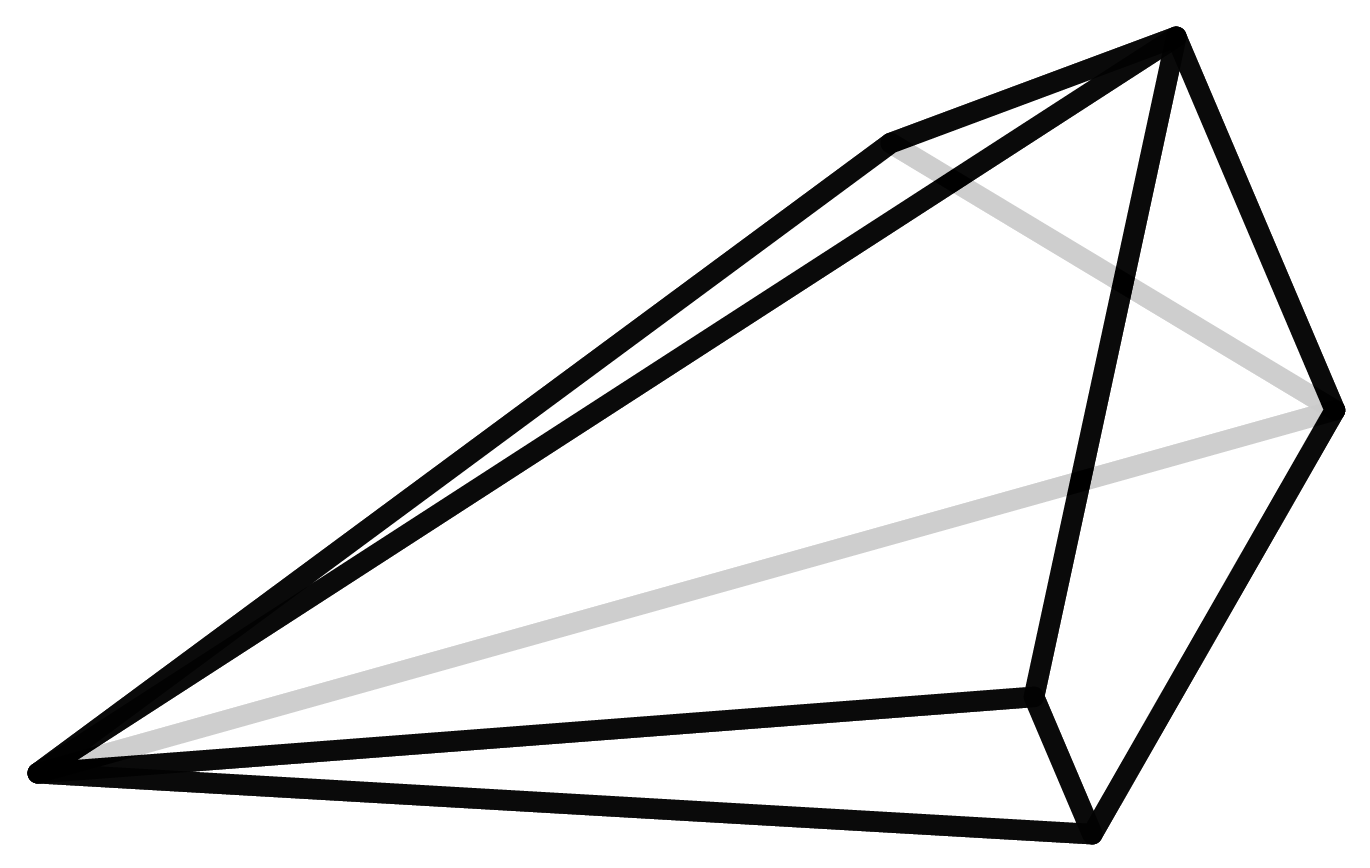





In order to find out how many polyhedra types actually exist for each number of vertices, we have to create and list them. But how do you know that this list is complete and no polyhedron is counted twice? In geometry, Steinitz’s Theorem states that each polyhedron can be uniquely assigned to a graph with certain properties. (Here the notion of a graph is not referring to the ones living in coordinate systems but the ones that are subject to graph theory). These graphs are mathematically easier to grasp and therefore count. But even for this, you will need a computer because the numbers get very large very fast. The number of seven- and eight-vertice polyhedra, 34 and 257 respectively, were found back in 1899. For the discovery of the 2606 nine-vertice polyhedra in the year 1969 the invention of the computer was necessary.
Dimension
In mathematics, there are many ways to interpret dimensions. One way is to imagine dimensions as the number of variables. For example, the ingredients of an apple pie (flour, butter, sugar, eggs, baking soda and apples) can be understood as six variables and therefore the apple pie is a six-dimensional object.
By looking at photos and films, which are a representation of our three-dimensional world in a two-dimensional medium, we are used to seeing an extra dimension. This process of mapping a higher dimension into a lower one, that is taking a two-dimensional photograph of the three-dimensional world, is called a projection in mathematics.
Unfortunately, it is not possible to truly represent four-dimensional space in the three-dimensional space surrounding us, but we can use projections to understand it. For example, if you look at a cube, its faces are squares. A square can be thought of as a two-dimensional cube, because all its sides are the same length, so the sides of the three-dimensional cube are two-dimensional cubes. This idea extends to higher dimensions. The side surfaces of a four-dimensional cube are three-dimensional cubes. The result is a so-called tesseract. Here is a link to a video where this relationship is graphically visualized.
Convex/Convexity
When we speak of polyhedra, we silently assume that they are convex polyhedra. Convex means that there are no indentations, cavities or holes. The mathematical definition of convexity states that for any two points that lie within a set, a straight line connecting them must lie completely within the set.

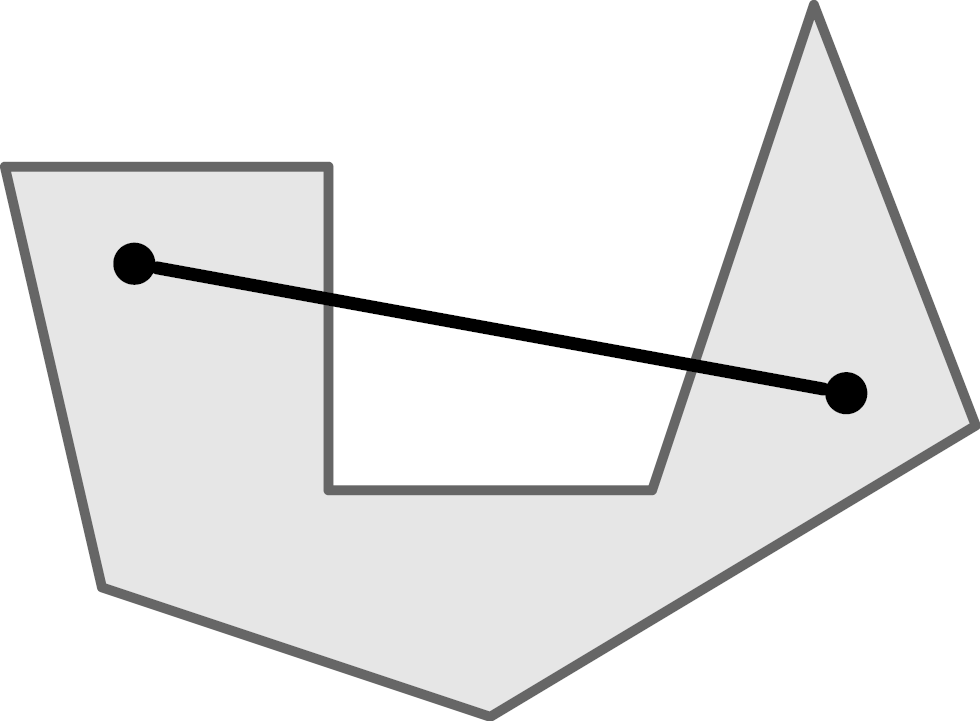
On the left a convex, on the right a non-convex object.
Combinatorial Type
Each polyhedron can be geometrically realized in different ways. It can be big or small, and its shape can also be changed, as long as the structure of the vertices, edges and surfaces remains the same. This structure, which is the number of edges meeting at the vertices, and the number of vertices belonging to each surface, is called the combinatorial type of a polyhedron. We call two polyhedra combinatorially equivalent if they possess the same combinatorial type, i.e., one can uniquely assign vertices to each other so that if two vertices in one polyhedron are connected by an edge, then the vertices in the other polyhedron are connected by an edge. Every polyhedron has an infinite number of different geometric interpretations. If you choose a polyhedron on Polytopia.eu, you will adopt the entire combinatorial type. So you have actually adopted infinitely many polyhedra. To make it less confusing and easier to make the model, we have chosen a clear realization of the polyhedron. These are the so-called Koebe-Andreev-Thurston realizations of polyhedra. In particular, these realizations have a sphere inscribed inside the polyhedra that touches each of the edges at exactly one point. In particular, each surface contains a circle that touches the edges just once.

f-Vector
The f-vector of the polyhedron indicates how many vertices, edges, and faces it has. A vector in this case is not a geometric quantity but only the way of representing these numbers. The cube consists of 8 vertices, 12 edges, and 6 faces, and thus has the f-vector (8,12,6). However, the polyhedra are not uniquely determined by this vector. There may be other polyhedra with the same f-vector that have a completely different structure. We call these polyhedra siblings.


Here we see a cube and its sister. She also possesses 6 faces, 12 edges, and 8 vertices but contains an entirely different structure that the cube.
Mathematical Models
Physical models and their construction have long played an important role in mathematics. For one thing, there was simply no other way to understand ideas in a three-dimensional environment. Of course, three-dimensional models can always be drawn, but then the drawing is only a projection of the model onto the plane, much like taking a picture of the model. When it comes to photos of familiar objects, recognizing the space does not cause us any problems, because we know, for example, that a table is usually right-angled. If we see a perspectively distorted table in a photo, we intuitively know about the right angles. Of course, this intuition is not there when trying to understand the structure of an unfamiliar geometric object. In order to recognize certain properties, such as an axis of symmetry, it is very helpful to actually hold an object in your hand and turn it.
Models serve not only to gain knowledge but also to share knowledge. To make their research accessible to others, mathematicians needed a way to visualize it. Nowadays, this is done mainly with computers. There is a lot of software to generate mathematical and geometric graphics. Rotation of a model using this software also counteracts the problem of restriction to the flat screen.
Dürer’s Conjecture
Although mathematicians have been dealing with polyhedra since ancient times, not everything is known about them. For one thing, every question that is answered only brings about new questions. For example, the number of three-dimensional polyhedra is known only up to 18 vertices. If somebody should find out how many polyhedra there are with 19 vertices, one can immediately ask about the number of polyhedra with 20 vertices. There are also questions that have been waiting a long time for an answer. A „nice“ example, because it is easy to understand and yet still an unsolved problem, is the so-called Dürer conjecture. The painter Albrecht Dürer spent some years studying mathematics and the concept of the net of a polyhedron goes back to him. In his book, „The Painter’s Manual“ he drew nets of several polyhedra.

A net of a polyhedron is created by considering the polyhedron as an empty shell, which is cut along its edges in such a way that it remains connected but can be laid flat without distorting the faces. The question behind Dürer’s conjecture is whether this is possible for every polyhedron such that the faces do not overlap when it is unfolded. In other words, does every polyhedron have a net?
To date, many mathematicians have considered this question and there are some intermediate results. For example, it is known that you can unfold any polyhedron without overlap if you pull and distort the faces and thus change its geometrical realization but not its structure (s. https://arxiv.org/pdf/1305.3231.pdf). The only polyhedron for which we know for sure that can always be unfolded without changing its geometrical structure is the tetrahedron.
Since we have automatically generated the unfoldings for the polyhedra in our project, it is possible that the net of your adopted polyhedron is overlapping. If so, write us an email!
Siblings
Polyhedra are siblings if they contain the same number of vertices, edges and faces, hence the same f-vector. Similar to human siblings, some polyhedral siblings do look alike each other while others have a completely different form. The cube consists of 8 vertices, 12 edges and 6 faces. These numbers do not uniquely define its structure. There are polyhedra who have the same f-vector but an entirely different structure.
Siblings:Polythagoras, Rheingau-Franken-Verewigung, Karl der 1, Yghoodron, Nike auf die 1, Hans-Paul-187.te, Spiky Tail, Garry, Sibling 1002447, Sibling 1000228, Sibling 1000005, Sibling 1000010, Sibling 1000012, Sibling 1000016, Sibling 1000018, Sibling 1000026, Sibling 1000028, Sibling 1000030, Sibling 1000032, Sibling 1000035, . . .
Sibling 1000038, Sibling 1000039, Sibling 1000043, Sibling 1000048, Sibling 1000050, Sibling 1000052, Sibling 1000055, Sibling 1000056, Sibling 1000057, Sibling 1000060, Sibling 1000061, Sibling 1000070, Sibling 1000075, Sibling 1000077, Sibling 1000083, Sibling 1000084, Sibling 1000087, Sibling 1000089, Sibling 1000092, Sibling 1000097, Sibling 1000106, Sibling 1000115, Sibling 1000118, Sibling 1000121, Sibling 1000122, Sibling 1000125, Sibling 1000131, Sibling 1000133, Sibling 1000135, Sibling 1000151, Sibling 1000164, Sibling 1000168, Sibling 1000172, Sibling 1000173, Sibling 1000175, Sibling 1000178, Sibling 1000181, Sibling 1000191, Sibling 1000192, Sibling 1000193, Sibling 1000203, Sibling 1000208, Sibling 1000210, Sibling 1000215, Sibling 1000217, Sibling 1000219, Sibling 1000222, Sibling 1000224, Sibling 1000230, Sibling 1000236, Sibling 1000238, Sibling 1000240, Sibling 1000246, Sibling 1000247, Sibling 1000252, Sibling 1000260, Sibling 1000261, Sibling 1000264, Sibling 1000267, Sibling 1000269, Sibling 1000272, Sibling 1000276, Sibling 1000280, Sibling 1000284, Sibling 1000299, Sibling 1000303, Sibling 1000311, Sibling 1000313, Sibling 1000315, Sibling 1000317, Sibling 1000319, Sibling 1000321, Sibling 1000323, Sibling 1000325, Sibling 1000328, Sibling 1000330, Sibling 1000332, Sibling 1000334, Sibling 1000340, Sibling 1000342, Sibling 1000344, Sibling 1000345, Sibling 1000347, Sibling 1000350, Sibling 1000352, Sibling 1000354, Sibling 1000355, Sibling 1000361, Sibling 1000363, Sibling 1000378, Sibling 1000384, Sibling 1000387, Sibling 1000388, Sibling 1000394, Sibling 1000400, Sibling 1000404, Sibling 1000407, Sibling 1000408, Sibling 1000411, Sibling 1000413, Sibling 1000417, Sibling 1000421, Sibling 1000423, Sibling 1000424, Sibling 1000426, Sibling 1000430, Sibling 1000431, Sibling 1000432, Sibling 1000442, Sibling 1000446, Sibling 1000448, Sibling 1000450, Sibling 1000457, Sibling 1000461, Sibling 1000462, Sibling 1000465, Sibling 1000466, Sibling 1000468, Sibling 1000472, Sibling 1000474, Sibling 1000476, Sibling 1000477, Sibling 1000479, Sibling 1000483, Sibling 1000485, Sibling 1000486, Sibling 1000494, Sibling 1000498, Sibling 1000500, Sibling 1000507, Sibling 1000510, Sibling 1000513, Sibling 1000515, Sibling 1000518, Sibling 1000520, Sibling 1000526, Sibling 1000532, Sibling 1000533, Sibling 1000536, Sibling 1000540, Sibling 1000548, Sibling 1000558, Sibling 1000560, Sibling 1000564, Sibling 1000566, Sibling 1000568, Sibling 1000570, Sibling 1000573, Sibling 1000575, Sibling 1000578, Sibling 1000581, Sibling 1000583, Sibling 1000585, Sibling 1000587, Sibling 1000589, Sibling 1000591, Sibling 1000593, Sibling 1000594, Sibling 1000597, Sibling 1000601, Sibling 1000603, Sibling 1000607, Sibling 1000610, Sibling 1000613, Sibling 1000614, Sibling 1000618, Sibling 1000620, Sibling 1000621, Sibling 1000624, Sibling 1000626, Sibling 1000629, Sibling 1000640, Sibling 1000643, Sibling 1000645, Sibling 1000649, Sibling 1000651, Sibling 1000653, Sibling 1000655, Sibling 1000657, Sibling 1000658, Sibling 1000661, Sibling 1000665, Sibling 1000668, Sibling 1000671, Sibling 1000675, Sibling 1000678, Sibling 1000684, Sibling 1000693, Sibling 1000694, Sibling 1000705, Sibling 1000710, Sibling 1000711, Sibling 1000712, Sibling 1000714, Sibling 1000720, Sibling 1000721, Sibling 1000722, Sibling 1000726, Sibling 1000728, Sibling 1000729, Sibling 1000731, Sibling 1000735, Sibling 1000738, Sibling 1000739, Sibling 1000741, Sibling 1000745, Sibling 1000748, Sibling 1000749, Sibling 1000756, Sibling 1000760, Sibling 1000762, Sibling 1000766, Sibling 1000767, Sibling 1000771, Sibling 1000773, Sibling 1000775, Sibling 1000776, Sibling 1000778, Sibling 1000783, Sibling 1000785, Sibling 1000792, Sibling 1000804, Sibling 1000805, Sibling 1000808, Sibling 1000811, Sibling 1000818, Sibling 1000819, Sibling 1000822, Sibling 1000823, Sibling 1000827, Sibling 1000829, Sibling 1000834, Sibling 1000837, Sibling 1000839, Sibling 1000845, Sibling 1000851, Sibling 1000863, Sibling 1000868, Sibling 1000871, Sibling 1000873, Sibling 1000876, Sibling 1000879, Sibling 1000883, Sibling 1000889, Sibling 1000890, Sibling 1000894, Sibling 1000896, Sibling 1000899, Sibling 1000905, Sibling 1000908, Sibling 1000910, Sibling 1000915, Sibling 1000918, Sibling 1000920, Sibling 1000923, Sibling 1000927, Sibling 1000928, Sibling 1000935, Sibling 1000939, Sibling 1000943, Sibling 1000945, Sibling 1000947, Sibling 1000949, Sibling 1000950, Sibling 1000951, Sibling 1000952, Sibling 1000959, Sibling 1000961, Sibling 1000964, Sibling 1000974, Sibling 1000976, Sibling 1000978, Sibling 1000989, Sibling 1000992, Sibling 1000999, Sibling 1001002, Sibling 1001004, Sibling 1001005, Sibling 1001008, Sibling 1001015, Sibling 1001018, Sibling 1001021, Sibling 1001023, Sibling 1001032, Sibling 1001035, Sibling 1001038, Sibling 1001040, Sibling 1001041, Sibling 1001046, Sibling 1001047, Sibling 1001050, Sibling 1001053, Sibling 1001055, Sibling 1001057, Sibling 1001058, Sibling 1001060, Sibling 1001061, Sibling 1001062, Sibling 1001065, Sibling 1001068, Sibling 1001072, Sibling 1001074, Sibling 1001088, Sibling 1001090, Sibling 1001092, Sibling 1001095, Sibling 1001102, Sibling 1001104, Sibling 1001107, Sibling 1001110, Sibling 1001112, Sibling 1001115, Sibling 1001119, Sibling 1001122, Sibling 1001124, Sibling 1001126, Sibling 1001131, Sibling 1001133, Sibling 1001136, Sibling 1001139, Sibling 1001141, Sibling 1001143, Sibling 1001146, Sibling 1001150, Sibling 1001152, Sibling 1001154, Sibling 1001156, Sibling 1001158, Sibling 1001168, Sibling 1001171, Sibling 1001187, Sibling 1001191, Sibling 1001194, Sibling 1001196, Sibling 1001201, Sibling 1001203, Sibling 1001204, Sibling 1001206, Sibling 1001215, Sibling 1001216, Sibling 1001218, Sibling 1001220, Sibling 1001224, Sibling 1001228, Sibling 1001230, Sibling 1001233, Sibling 1001236, Sibling 1001239, Sibling 1001240, Sibling 1001247, Sibling 1001249, Sibling 1001252, Sibling 1001254, Sibling 1001256, Sibling 1001258, Sibling 1001262, Sibling 1001265, Sibling 1001270, Sibling 1001278, Sibling 1001286, Sibling 1001291, Sibling 1001294, Sibling 1001299, Sibling 1001301, Sibling 1001303, Sibling 1001311, Sibling 1001316, Sibling 1001321, Sibling 1001326, Sibling 1001329, Sibling 1001332, Sibling 1001334, Sibling 1001336, Sibling 1001338, Sibling 1001340, Sibling 1001342, Sibling 1001345, Sibling 1001346, Sibling 1001348, Sibling 1001358, Sibling 1001360, Sibling 1001363, Sibling 1001365, Sibling 1001369, Sibling 1001374, Sibling 1001377, Sibling 1001381, Sibling 1001385, Sibling 1001386, Sibling 1001389, Sibling 1001392, Sibling 1001394, Sibling 1001397, Sibling 1001399, Sibling 1001402, Sibling 1001407, Sibling 1001408, Sibling 1001411, Sibling 1001413, Sibling 1001418, Sibling 1001424, Sibling 1001427, Sibling 1001429, Sibling 1001431, Sibling 1001432, Sibling 1001437, Sibling 1001438, Sibling 1001443, Sibling 1001445, Sibling 1001446, Sibling 1001448, Sibling 1001451, Sibling 1001453, Sibling 1001455, Sibling 1001457, Sibling 1001459, Sibling 1001464, Sibling 1001468, Sibling 1001471, Sibling 1001473, Sibling 1001480, Sibling 1001483, Sibling 1001485, Sibling 1001487, Sibling 1001492, Sibling 1001493, Sibling 1001495, Sibling 1001498, Sibling 1001502, Sibling 1001504, Sibling 1001505, Sibling 1001508, Sibling 1001511, Sibling 1001512, Sibling 1001515, Sibling 1001526, Sibling 1001529, Sibling 1001532, Sibling 1001535, Sibling 1001543, Sibling 1001545, Sibling 1001547, Sibling 1001555, Sibling 1001556, Sibling 1001560, Sibling 1001562, Sibling 1001563, Sibling 1001564, Sibling 1001574, Sibling 1001576, Sibling 1001577, Sibling 1001578, Sibling 1001583, Sibling 1001585, Sibling 1001588, Sibling 1001592, Sibling 1001595, Sibling 1001596, Sibling 1001601, Sibling 1001603, Sibling 1001605, Sibling 1001607, Sibling 1001609, Sibling 1001611, Sibling 1001620, Sibling 1001623, Sibling 1001627, Sibling 1001630, Sibling 1001637, Sibling 1001639, Sibling 1001644, Sibling 1001646, Sibling 1001648, Sibling 1001650, Sibling 1001655, Sibling 1001657, Sibling 1001659, Sibling 1001661, Sibling 1001662, Sibling 1001669, Sibling 1001671, Sibling 1001675, Sibling 1001680, Sibling 1001684, Sibling 1001687, Sibling 1001692, Sibling 1001693, Sibling 1001696, Sibling 1001702, Sibling 1001706, Sibling 1001713, Sibling 1001716, Sibling 1001719, Sibling 1001720, Sibling 1001723, Sibling 1001726, Sibling 1001729, Sibling 1001735, Sibling 1001738, Sibling 1001740, Sibling 1001741, Sibling 1001743, Sibling 1001746, Sibling 1001749, Sibling 1001751, Sibling 1001754, Sibling 1001756, Sibling 1001757, Sibling 1001772, Sibling 1001780, Sibling 1001787, Sibling 1001799, Sibling 1001801, Sibling 1001804, Sibling 1001808, Sibling 1001810, Sibling 1001812, Sibling 1001814, Sibling 1001816, Sibling 1001818, Sibling 1001819, Sibling 1001822, Sibling 1001827, Sibling 1001828, Sibling 1001832, Sibling 1001834, Sibling 1001836, Sibling 1001839, Sibling 1001840, Sibling 1001843, Sibling 1001844, Sibling 1001845, Sibling 1001849, Sibling 1001855, Sibling 1001858, Sibling 1001860, Sibling 1001862, Sibling 1001868, Sibling 1001870, Sibling 1001872, Sibling 1001874, Sibling 1001876, Sibling 1001879, Sibling 1001881, Sibling 1001883, Sibling 1001887, Sibling 1001891, Sibling 1001893, Sibling 1001894, Sibling 1001896, Sibling 1001904, Sibling 1001906, Sibling 1001909, Sibling 1001910, Sibling 1001911, Sibling 1001915, Sibling 1001918, Sibling 1001920, Sibling 1001922, Sibling 1001924, Sibling 1001926, Sibling 1001927, Sibling 1001931, Sibling 1001936, Sibling 1001938, Sibling 1001942, Sibling 1001951, Sibling 1001955, Sibling 1001962, Sibling 1001966, Sibling 1001970, Sibling 1001973, Sibling 1001980, Sibling 1001982, Sibling 1001986, Sibling 1001988, Sibling 1001989, Sibling 1001990, Sibling 1001993, Sibling 1001994, Sibling 1001999, Sibling 1002002, Sibling 1002005, Sibling 1002012, Sibling 1002014, Sibling 1002017, Sibling 1002033, Sibling 1002034, Sibling 1002038, Sibling 1002043, Sibling 1002047, Sibling 1002054, Sibling 1002056, Sibling 1002062, Sibling 1002066, Sibling 1002068, Sibling 1002070, Sibling 1002073, Sibling 1002077, Sibling 1002080, Sibling 1002081, Sibling 1002085, Sibling 1002088, Sibling 1002090, Sibling 1002093, Sibling 1002094, Sibling 1002096, Sibling 1002098, Sibling 1002099, Sibling 1002101, Sibling 1002102, Sibling 1002107, Sibling 1002108, Sibling 1002110, Sibling 1002113, Sibling 1002114, Sibling 1002118, Sibling 1002120, Sibling 1002122, Sibling 1002127, Sibling 1002135, Sibling 1002138, Sibling 1002144, Sibling 1002145, Sibling 1002148, Sibling 1002152, Sibling 1002154, Sibling 1002158, Sibling 1002169, Sibling 1002173, Sibling 1002179, Sibling 1002182, Sibling 1002195, Sibling 1002202, Sibling 1002204, Sibling 1002206, Sibling 1002207, Sibling 1002216, Sibling 1002219, Sibling 1002220, Sibling 1002226, Sibling 1002229, Sibling 1002231, Sibling 1002234, Sibling 1002235, Sibling 1002240, Sibling 1002242, Sibling 1002244, Sibling 1002251, Sibling 1002254, Sibling 1002255, Sibling 1002257, Sibling 1002263, Sibling 1002266, Sibling 1002268, Sibling 1002271, Sibling 1002272, Sibling 1002274, Sibling 1002278, Sibling 1002283, Sibling 1002284, Sibling 1002288, Sibling 1002289, Sibling 1002291, Sibling 1002299, Sibling 1002307, Sibling 1002308, Sibling 1002317, Sibling 1002323, Sibling 1002325, Sibling 1002338, Sibling 1002339, Sibling 1002344, Sibling 1002346, Sibling 1002347, Sibling 1002348, Sibling 1002355, Sibling 1002362, Sibling 1002369, Sibling 1002370, Sibling 1002381, Sibling 1002384, Sibling 1002386, Sibling 1002388, Sibling 1002390, Sibling 1002395, Sibling 1002396, Sibling 1002404, Sibling 1002405, Sibling 1002410, Sibling 1002412, Sibling 1002413, Sibling 1002419, Sibling 1002422, Sibling 1002424, Sibling 1002426, Sibling 1002427, Sibling 1002431, Sibling 1002432, Sibling 1002436, Sibling 1002440, Sibling 1002443, Sibling 1002444, Sibling 1002451, Sibling 1002453, Sibling 1002456, Sibling 1002463, Sibling 1002466, Sibling 1002467, Sibling 1002472, Sibling 1002476, Sibling 1002488, Sibling 1002491, Sibling 1002497, Sibling 1002500, Sibling 1002504, Sibling 1002505, Sibling 1002507, Sibling 1002508, Sibling 1002510, Sibling 1002516, Sibling 1002518, Sibling 1002521, Sibling 1002522, Sibling 1002526, Sibling 1002528, Sibling 1002530, Sibling 1002532, Sibling 1002533, Sibling 1002537, Sibling 1002545, Sibling 1002547, Sibling 1002551, Sibling 1002554, Sibling 1002556, Sibling 1002557, Sibling 1002560, Sibling 1002565, Sibling 1002568, Sibling 1002572, Sibling 1002574, Sibling 1002580, Sibling 1002582, Sibling 1002586, Sibling 1002596, Sibling 1002603, Sibling 1002606, Sibling 1002609, Sibling 1002611, Sibling 1002612, Sibling 1002621, Sibling 1002623, Sibling 1002626, Sibling 1002634, Sibling 1002637, Sibling 1002643, Sibling 1002645, Sibling 1002647, Sibling 1002650, Sibling 1002653, Sibling 1002656, Sibling 1002658, Sibling 1002661, Sibling 1002664, Sibling 1002666, Sibling 1002673, Sibling 1002676, Sibling 1002680, Sibling 1002681, Sibling 1002683, Sibling 1002689, Sibling 1002691, Sibling 1002692, Sibling 1002694, Sibling 1002695, Sibling 1002697, Sibling 1002699, Sibling 1002702, Sibling 1002705, Sibling 1002710, Sibling 1002713, Sibling 1002715, Sibling 1002716, Sibling 1002718, Sibling 1002720, Sibling 1002721, Sibling 1002728, Sibling 1002729, Sibling 1002734, Sibling 1002737, Sibling 1002744, Sibling 1002747, Sibling 1002748, Sibling 1002750, Sibling 1002751, Sibling 1002754, Sibling 1002757, Sibling 1002759, Sibling 1002764, Sibling 1002766, Sibling 1002767, Sibling 1002770, Sibling 1002774, Sibling 1002777, Sibling 1002778, Sibling 1002782, Sibling 1002783, Sibling 1002794, Sibling 1002803, Sibling 1002805, Sibling 1002807, Sibling 1002809, Sibling 1002811, Sibling 1002813, Sibling 1002821, Sibling 1002825, Sibling 1002826, Sibling 1002831, Sibling 1002833, Sibling 1002834, Sibling 1002836, Sibling 1002838, Sibling 1002843, Sibling 1002854, Sibling 1002860, Sibling 1002863, Sibling 1002869, Sibling 1002872, Sibling 1002873, Sibling 1002881, Sibling 1002884, Sibling 1002892, Sibling 1002894, Sibling 1002895, Sibling 1002911, Sibling 1002917, Sibling 1002923, Sibling 1002926, Sibling 1002927, Sibling 1002929, Sibling 1002930, Sibling 1002933, Sibling 1002934, Sibling 1002936, Sibling 1002940, Sibling 1002946, Sibling 1002952, Sibling 1002956, Sibling 1002968, Sibling 1002971, Sibling 1002972, Sibling 1002985,
hide
Fields of Application of Polyhedra
From a purely mathematical perspective, polyhedra are, above all, beautiful and interesting, and their exploration requires no further justification. Nevertheless, one can obviously ask the question, which is almost as old as mathematics itself, what do you really need it for?
One important application of polyhedra is Linear Optimization. It is a method that is often used in business, among other areas, to make decisions that depend on many factors.
One example is making a timetable and network line for a public transportation system. There are many variables to be considered, such as arrival and departure times, operational costs, line capacities and so on. City planners want to meet public expectations for how often a train comes and also minimize the costs, run enough trains to carry enough passengers, but are also limited to the number of trains on the tracks for safety reasons. From these variables, a system of linear inequalities arise and their set of possible solutions form a polytope. The optimal solutions are located at the vertices of that polytope. So finding these vertices gives city planners optimal ways to build the most effective timetable possible.
How do the names of mathematical objects actually come about?
The Greek word for five is “penta”, so a pentagon is a five sided polygon. The hexagon, heptagon, and octagon get their names in the same way, but there is no trigon. Instead, a triangle is the 3-sided polygon and gets its name from its three angles. But then what is a square? Clearly, it is not enough that the name alone can give a definition. Although “square” does not describe the features, it is a commonly known shape. Therefore, it is necessary to actually use the name so that its meaning is well known.
Mathematical objects are also often named after mathematicians. More often than not, these objects and other concepts have been named after male mathematicians, but female mathematicians have also left a legacy behind. The Noetherian rings, named after Emmy Noether, and the Witch of Agnesi, after Maria Agnesi are some examples, but there is a need to close the gender gap.
Mostly, the objects that are named after mathematicians are given these names by scientists. The concept of a ring was already known, but to be able to distinguish the rings that Emmy Noether wrote about from the general ones, one talked about Noetherian rings. The convention of these rings came first and later a definition was established.
The Dürer conjecture was never proposed by the painter Albrecht Dürer himself but the underlying nets of polyhedra go back to him. The conjecture itself was posed by the mathematician G. C. Shephard in 1975. Why then it is known as Dürer’s and not Shephard’s conjecture, one can only speculate.
In summary, the rules and conventions for naming are rather ambiguous. It is similar to getting a nickname – if everyone knows who or what is meant, then the name sticks.
